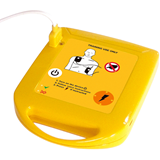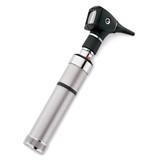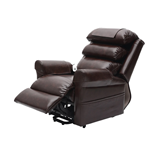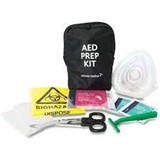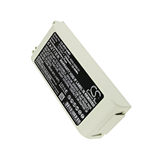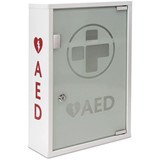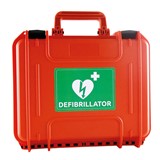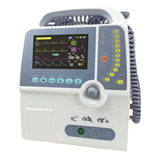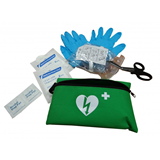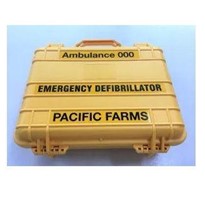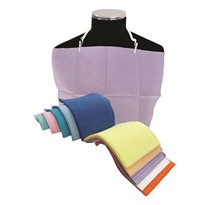More than 33,000 out of hospital sudden cardiac arrests occur every year in Australia. Sadly, less than 10% of patients survive, making sudden cardiac arrest one of our biggest killers. Sudden cardiac arrest does not discriminate, it can happen to anyone of any age or fitness level and often occurs without warning. However, if a person receives defibrillation within the first few minutes of having a sudden cardiac arrest their chance of survival is increased to beyond 70% making a defibrillator essential to a cardiac arrest sufferers survival.
The best method to ensure the survival of a cardiac arrest sufferer is Call, Push, Shock.
Call - for emergency assistance and advanced care.
Push – begin CPR.
Shock – use a defibrillator to restore normal heart rhythm.
So what is a defibrillator?
An automated external defibrillator (AED) is a portable electronic device that diagnoses life threatening abnormal heart rhythms that can cause a cardiac arrest and the only device that can treat sudden cardiac arrest. With such an important purpose it is important to choose the right AED for your specific requirements and level of training.
Do I need training to use an AED?
The short answer, is no, you do not need any formal training to use an AED. They have visual and audio guides that instruct you through every step of the process and many models provide feedback on how well your efforts are going. Anyone can use an AED, it’s as simple as applying pads and pushing a button. The AED will then read the heart rhythm of the person you have applied the pads to and determine whether a shock is necessary, this means that you cannot harm anyone using an AED because it will not shock unless it’s necessary.
The difference in AED models
Now that you know how easy it is to use an AED you may be wondering how there are so many different options when it comes to choosing the right one for you. There are a few things to be considered when choosing an AED that is right for you such as where your device will be stored, environmental factors that may affect the device, who will be using it, who it is most likely to be used on, how extensive the feedback features are, consumables and price.
Storage and environment
The type of AED that is right for you will differ depending on its end use. For example, is the AED going to be stored in a cabinet in an office environment or are you expecting to take it on remote trekking expeditions or into situations that it will be exposed to the elements? AEDs can differ in size, weight and IP rating (International Protection Rating), which is their resistance against the intrusion of solid objects or dust, accidental contact, and water. For an office environment, resistance to the elements is not important but for a more demanding environment, an AED such as the HeartSine 360P that is compact, weighing just 1.25kg, aircraft rated, highly resistant to impact damage and water may be necessary.
Who will be using the AED
Although there is no formal training needed to use an AED the people that will be using the device should always be considered. It is recommended that everyone who has access to an AED is made familiar with how it works and where it is located so that in the event of a sudden cardiac arrest action can be taken quickly. The Heartsine SAM 500P is one of the most intelligent defibrillators available. Featuring CPR Advisor, which provides real time feedback as to the effectiveness of the CPR being administered. After consideration of the user, it is also worth thinking about who the AED is likely to be used on. For example, if an AED is located in a childcare centre then picking a device with a child mode switch such as the LifePak CR2 Essential or a paediatric pad pack is important as an infant requires less of a shock than an adult to restore a normal heart rhythm.
Consumables and price
Speaking of paediatric pads, this brings us to the next point of consumables and price. Generally speaking there are only two consumable components of an AED, the batteries and pads. These need to be replaced once their expiry date has been met or the device has been used. An AED is a multi-use item that does not require servicing, however the batteries and pads do require replacement every so often or once used. Luckily most models of AED self-monitor and will notify you when replacement of any part is due. Alternatively, AED Authority’s Concierge program can take any worry away by providing you with a dedicated professional that will contact you when replacement is due. To reduce effort and cost many AED models come with a single battery and pad pack with a single expiry. Some of the more expensive devices such as the LifePak 1000 are designed with advanced care professionals in mind come with features such as an ECG attachment that provides data from the time of incident, but these more expensive options are not necessary in most cases and all AED models are effective in helping to save a life.
If this all sounds like a lot, it’s because it is. There are a range of things to consider when choosing the right AED for your needs and the more information you read the harder it can be.
Luckily we are here to help, AED Authority’s mission is to increase the sudden cardiac arrest survival rate by getting more AEDs in more workplaces around the country. We are experts in all things AED and we are ready to help you tailor an AED solution for your needs and budget. Talk to the team today to ensure that you are ready in the event of sudden cardiac arrest.
Knowing where your nearest AED is can save critical minutes and possibly save a life.




